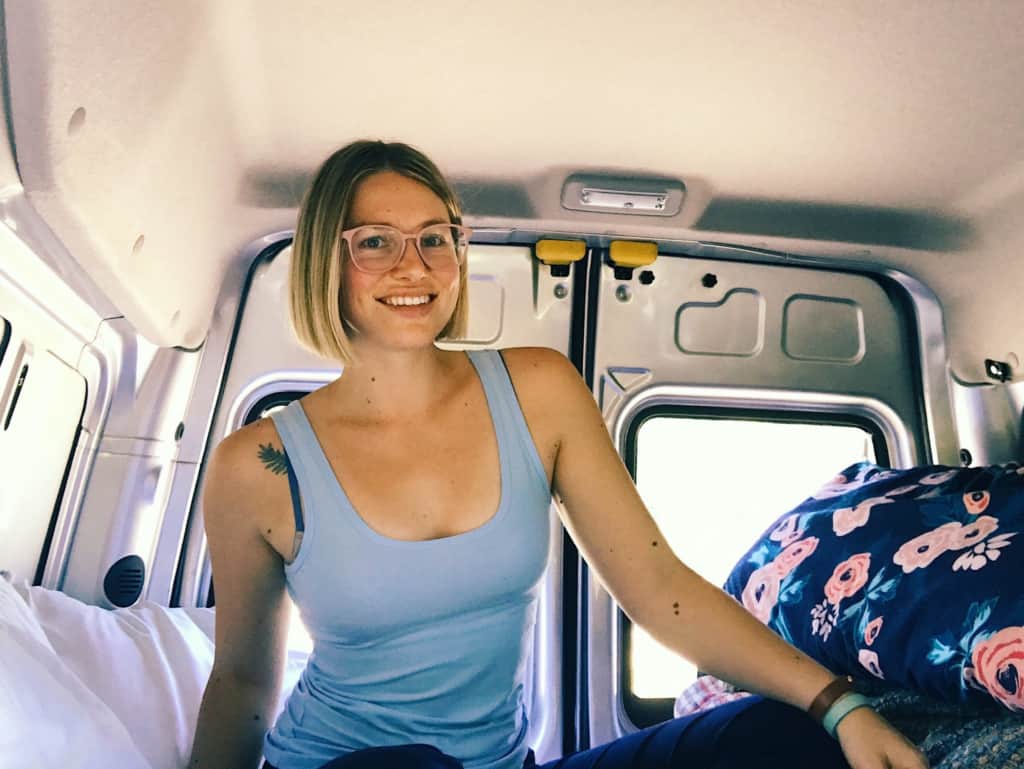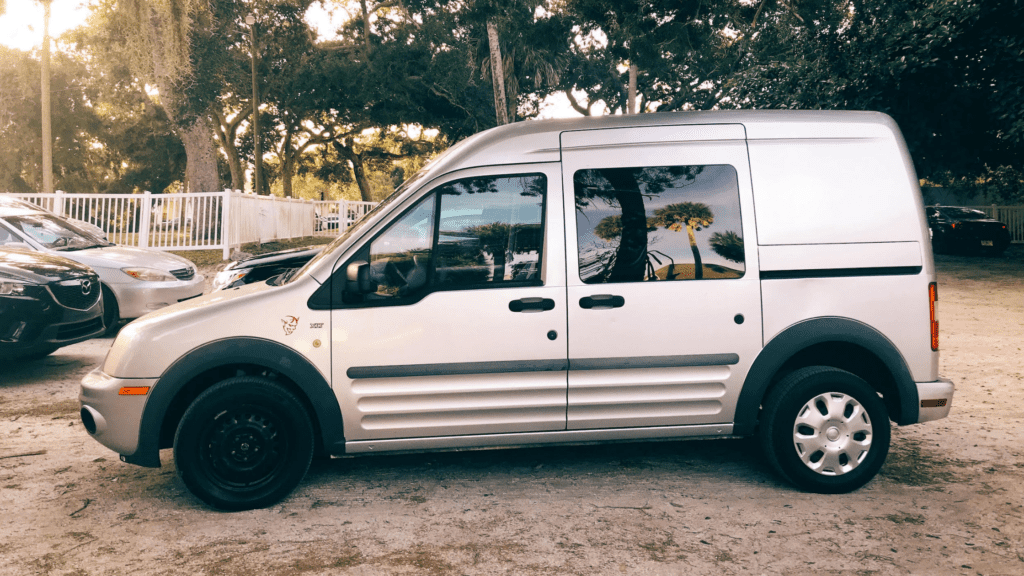My name is Ashlee Potter, I’m a 30 year old leathersmith and I travel part-time in a Ford Transit Connect. I’ve always loved travel, my first solo trip was at 17 and I never looked back.

The Creation of Ashlee's Business
For years I roamed around on planes, trains, and automobiles both internationally and in the US. In 2016 I started making leather goods inspired by my life on the road and at the same time I was

going through some pretty intense medical testing. I was ultimately diagnosed with Dysautonomia and a host of comorbid conditions.
I lost the ability to work as I had been so I focused on making my leather creations a full time gig. With this, Wandering Ash Tree was born. I started selling at markets and eventually moved from St. Louis to Florida to be able to do them more frequently (thank goodness for places with no off season). Just as I was set to move, my trusty old Jeep Cherokee failed on me. My new vehicle was going to need to be a work vehicle, a place to stay so I could work in more states, and my little refuge from the world.
Choosing the Ford Transit Connect As Her New Home on Wheels

While smaller than most of the vans you see converted on Instagram, I decided on the 2011 Ford Transit Connect for a few very specific reasons. It’s large enough to haul my market display and comfortably sleep, yet small enough to navigate city streets and skinny beach roads.
The 2011 Ford Transit Connect is a medium height–which does take away the ability to stand fully. But it’s tall enough to move around and to have a platform. I can sit up with ample room, but the van is also short enough to fit under a parking garage clearance. This may seem like a small thing but when you’re in the south and it’s hot, that garage cover does wonders for the interior temperature. Many garages across the country allow for overnight parking.
The best thing about the Connect, in my opinion, is the gas mileage. That was my deciding factor. Vans are notoriously bad on gas yet mine has gotten as much as 29mpg on the highway. You really can’t beat that if you’re going to be actively driving a lot.
Ford Transit Connect Buildout #1

My first build was pretty bare bones. Not only due to finances but you’d be surprised how much space a full art show display and product takes up. To allow for as much multitasking as possible, I went with a basic L-shaped wooden platform. The platform would fit all of my show stuff underneath with extra space for whatever essentials I needed.
My lights and fan (no roof vent for me) were battery operated and for the times I was at a campground or parked in someone’s driveway I installed an electric pass through outlet. This thing was pretty cool. Cut a small circle into the van and on the outside there’s a female outlet with a cover. Inside, there’s a female outlet on a short cord. I keep an orange extension cord under the driver’s seat and I can just plug one end into the outside of the van and the other into a power source like a campground hookup and voila! Power in the van with only one $20 part.
This build wasn’t the prettiest #vanlife build but it worked. My first year she took me 33,000 miles (remember that gas mileage I mentioned?) to 63 markets in 5 states. Sometimes it was just a night or two in a new city with stops to my home base in between. But sometimes it would be weeks or a couple months at a time where I’d be creating new products in the mountains and in the back of the van. That simple cheap build was an office, a workshop, and a home.
The Pandemic Prompts Build #2
When the pandemic started my business took a huge hit as markets closed up. My full time home is a stationary fifth wheel in New Smyrna Beach, Florida–but the van became my refuge. I could safely drive a city or two away, get take out food from a small business, and park my van somewhere pretty to eat and read.
It was a safety pod on the go. Because the future of my livelihood is uncertain I took the opportunity to gut the van and rebuild. A friend and I took it from a single platform to a wee home on wheels. The van now has some insulation, flooring, a pull out couch/bed with a built in cedar chest, and a cabinet with two folding tables.
I’ve also added the small model Jackery power bank and a personal touch I’m quite happy with: a cane holder. My show supplies still fit though not in as comfortable or practical a way but that’s ok. If I start going back to markets at the rate I was previously I’ll figure out how to add it in. You trade some things for others and roll with changes as they come, right? But that aspect aside, I love being inside my van. I spend many late night hours parked at the beach by my house with the doors open to the water. Just hanging out, reading and making tea on my portable stove.
Ashlee's Perspective on Van Life

Often when people think of living in a van, they think of one extreme or the other. The expensive, beautiful builds with raised roofs and gorgeous views, or the societally shunned creeper vans down by the river. Those aren’t the only options and your reality will probably fall somewhere between the two.
You can have an inexpensive build in a small van; you don’t have to have an arsenal of tools. Or knowledge of carpentry, electric run and kitchen built. Not having those things won’t make your adventure less enjoyable or worthy–nor will it make you whatever parents feared people in vans were in the 90’s.
Your views are going to alternate between beautiful vistas and a whole lot of parking lots. As with everything in life it isn’t going to be the highlight reel or all gloom. You’re going to see amazing things and gain a sense of freedom and find places and opportunities you might have otherwise missed.
You’re also going to be woken up by the sound of a couple arguing in the car next to you at a rest stop, you’ll look around and wonder how such a small space got that messy, there will be nights where you can’t find a place to park and feel sad and frustrated and god forbid you accidentally spill your pee bucket. But then you’ll see that sunrise over the Walmart parking lot and think “huh, this is oddly kind of wonderful.”
The best tools to bring with you are a sense of humor and adventure. And another secret? You don’t have to do it full time. I love that I can drive mine daily at home or I can drive it daily as a home. Even if I’m not in it full time this van has saved me thousands of dollars in hotels just in 2019 alone and probably just as much in therapy bills.
However you do it, full time or part time, in a massive Sprinter or a small Transit or all compact in a little Pruis, there’s a lot of road out there and I hope you get to see some of it.
*********
Find Ashlee on Instagram at @WanderingAshTree or check out her beautifully hand-crafted leather goods at Wandering Ash Tree!

4 Comments
Richard Bobrik Jr
I just wanted to say that I really love this article and how this lady has created/impervised while saving a lot of money. Incidentally I have the exact 2011 Ford Transit Connect Cargo van XLT which is ironic that this is the same van this lady has. I admire her creativity, wisdom and outlooks/goals while building her business!
Lisa Strange
Ditto! I hope she sees our comments! 🙂
Lisa Strange
This article is a wonderful reminder to me that you can begin your travel adventures in a van sooner, rather than later. I’m in the planning stage for a van conversion and saving lots of Pintrest Pins and magazine articles. It’s easy to get caught up in thinking you need all the “bells and whistles”. It’s refreshing to be reminded that having the basics can also be satisfying.
Fellow Pisces
I don’t normally comment on stuff. But this article was nothing short of amazing. Worthy of all the praise for having overcome so many challenges that life threw her way. It’s inspiring and feel like many folks can benefit from reading this story. It’s shared experiences like this that help properly educate people without all the social-media glamorization. I’m from SWFL and we have tons of craft fairs here, would be awesome to check out her work in person! God bless 🥰